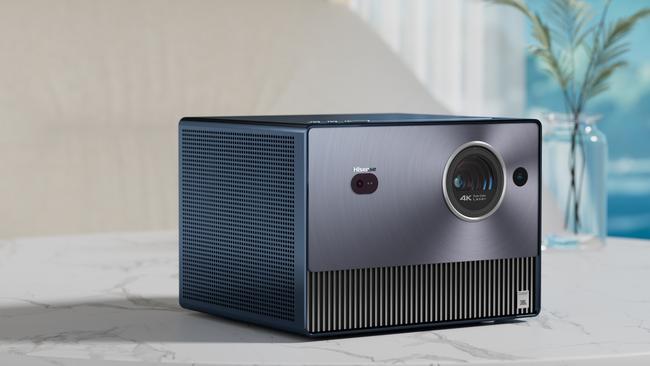Hisense offers a cinema-like experience in a 5kg box and surprise feature
Those who love home cinemas may find Hisense’s latest projector will change how you watch movies – especially for families wary of kids around lasers.

I’m cautious about using home projectors. Not because I don’t like them – I love replicating a cinema-like experience – but because I have a two-year-old son.
Projectors aren’t the most toddler-friendly devices. Like moths to a flame, they are drawn to the laser.
But Hisense assured me that it has found a way around this problem with the release of its C1 TriChroma Laser Mini Projector. It was one of the many products Hisense unveiled at CES – the world’s biggest consumer electronics show in Las Vegas earlier this year.
I wouldn’t classify it as a mini projector – particularly when rival LG showcased its compact CineBeam Qube, also at CES, which is about a third of the size and about $1000 cheaper than the C1’s $3499.
But there is a reason for the Hisense’s bulk. It crams in a heap of tech, including what Hisense’s national appliance trainer Chris Mayer calls “curious toddler” detection.
Pros
• Auto focus and realigns screen, even at sharp angles
• Can be viewed in rooms with medium ambient light
• Has good sound out of the box
Cons
• Is not a ‘mini’ projector despite its name
• Has a minimum throw of 1.73m.
‘Curious toddler’ detection
The C1 has a spherical sensor which can detect any “disturbance” or movement in front of the laser and instantly cut out. I tried this with my hand and the projector turned off its laser immediately.
“It’s an important feature for us,” says Mayer – who I like to call ‘Super Chris’ for his encyclopaedic knowledge of consumer tech.
While the sensor does its job, for parents who want to be assured by a few layers of redundancy, they can do what I did, which is place the C1 behind my TV and project it on the perpendicular wall. The laser was out of sight for any curious little eyes and despite the sharp angle, the image was still projected in perfect alignment.

Onboard artificial intelligence

This is what makes the extra $1000 worth it compared with LG’s CineBeam. The C1 boast what Hisense calls an “AutoMagic AI” adjustment, which automates the focus, keystone and screen alignment. It can even detect obstacles, such as light switches, modifying the screen size – which can be projected from 65-inches to 300-inches – accordingly.
If it gets bumped slightly, it can refocus automatically.
This worked well most of the time. I tried it on various walls around my home and for some the alignment wasn’t completely perfect. But a manual fine-tuning adjustment was able to remedy this.
The LG also has manual adjustment to be able to project on an angle, but it doesn’t have the same finesse as Hisense – after all, it’s a much smaller package, and it still needs to abide by the laws of physics.
Picture quality
So knowing my son is safe, and the screen is straight, how does the picture look, and can you watch it in daylight?
The projector works best in a dark environment – like all projectors – but can still be viewed in daylight. Not full sun, but it offers 1600 ANSI lumens (the CineBeam has 500 ANSI lumens), which can handle medium ambient light.
This is thanks to its three lasers – that’s what TriChroma means – which offers a brighter viewing experience compared with single laser projectors.
It also has Dolby Vision built in, allowing 4K high-dynamic range resolution. This can appear a mouthful, but I like Dolby Vision mainly because it offers a filmmaker mode, allowing you to watch movies in the colour that the filmmaker intended – we can thank Martin Scorsese for this, who despised the post-processing and motion smoothing on many modern home theatre set-ups that often creates what is known as a ‘cheap soap opera’ effect.

What about sound?
I had the C1 when I was also reviewing Sonos’s home theatre set-up – which included a subwoofer, two Era 300 speakers and Arc Soundbar. Paired with the C1, it gave a full cinematic blast.
But what about out of the box? Hisense has partnered with JBL to create a 1-litre sound chamber (another reason for its bulk). It also has Dolby Atmos – which provides spatial audio, or a 3D-like sound experience.
What this means is that even if the speaker is a few metres away from a wall it’s projected on, the sound still feels like it’s coming from its source on the screen.
It doesn’t sound tinny or distant, at least in small and average-sized lounge rooms.
Verdict
There is a lot to like about the C1. It projects clean images and sounds good and has onboard tech to make setting up easy – as well as protecting “curious toddlers”.
The only thing to be mindful of is it’s not a mini projector. It weighs almost 5kg. To project an 65-inch image (its smallest size) the C1 needs to be placed 1.73m away.
To go the full 300-inches, you need to place it almost 8m away. This compares with the CineBeam projecting a 80-inch image from 2.13m away.
But if it’s space you’re worried about, Hisense has another projector, its Laser Cinema Series PL1H, that can produce a 120-inch image with only a 42cm throw, which retails $200 cheaper than the C1 at $3299.





To join the conversation, please log in. Don't have an account? Register
Join the conversation, you are commenting as Logout